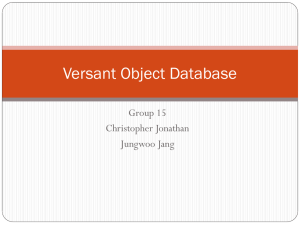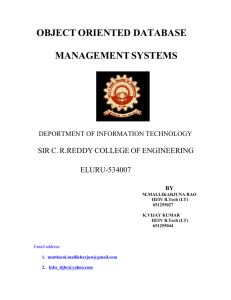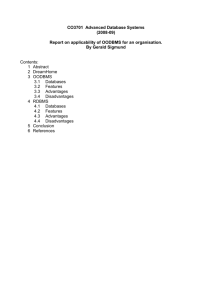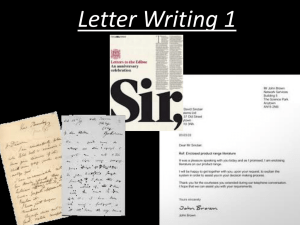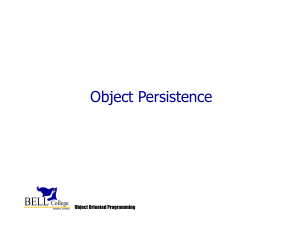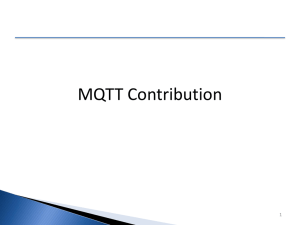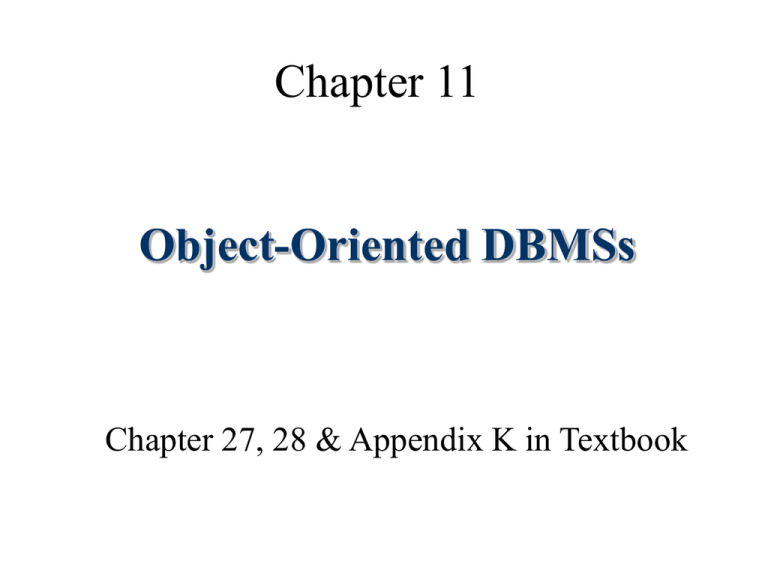
Chapter 11
Object-Oriented DBMSs
Chapter 27, 28 & Appendix K in Textbook
Advanced Database Applications
•
Computer-Aided Design (CAD).
•
Computer-Aided Manufacturing (CAM).
•
Computer-Aided Software Engineering (CASE).
•
Network Management Systems.
•
Office Information Systems (OIS) and Multimedia Systems.
•
Digital Publishing.
•
Geographic Information Systems (GIS).
•
Interactive and Dynamic Web sites.
•
Other applications with complex and interrelated objects and procedural
data.
OODBMS
2
Weaknesses of RDBMSs
•
Poor Representation of “Real World” Entities.
•
Semantic Overloading.
•
Poor Support for Integrity and Enterprise Constraints.
•
Homogeneous Data Structure.
•
Limited Operations.
•
Difficulty Handling Recursive Queries.
•
Impedance Mismatch.
•
Other Problems with RDBMSs:
o Transactions are generally short-lived and concurrency control protocols not
suited for long-lived transactions.
o Schema changes are difficult.
o RDBMSs are poor at navigational access.
OODBMS
3
Example - Recursive Query
OODBMS
StaffNo
MangrsSNo
StaffNo
S005
S004
S003
S002
S001
S004
S003
S002
S001
NULL
S005
S004
S003
S002
S001
S005
S005
S005
S004
S004
S003
MangrSNo
S004
S003
S002
S001
NULL
S003
S002
S001
S002
S001
S001
4
What is an OODBMS ?
OODBMS (Object-oriented Database Management System): is a database
with data stored in objects and collections NOT rows and tables.
Object Oriented Concepts:
Abstraction, encapsulation, and information hiding.
Objects and attributes.
Object identity.
Methods and messages.
Classes, subclasses, superclasses, and inheritance.
Overriding, Overloading, Polymorphism and Dynamic Binding.
OODBMS
5
OODBMS
Traditional DBS
• Persistence
• Sharing
• Transactions
• Concurrency Control
• Recovery Control
• Security
• Integrity
• Querying
Semantic Data Model
• Generalization
• Aggregation
OO Programming
• OID
• Encapsulation
• Inheritance
• Types & Classes
• Methods
• Complex objects
• Polymorphism
• Extensibility
Special Requirements
• Versioning
• Schema Evolution
OODBMS
OODBMS
6
Abstraction
Abstraction is the process of identifying essential aspects of an entity
and ignoring unimportant properties.
Concentrate on what an object is and what it does, before deciding how to
implement it.
OODBMS
7
Encapsulation & Information Hiding
Encapsulation: means that an object contains both data structure and set
of operations used to manipulate it.
Information Hiding: means separating external aspects of an object from
its internal details, which are hidden from outside.
• Allows internal details of an object to be changed without affecting applications that
use it, provided external details remain same.
• Provides data independence.
OODBMS
8
Objects
Object is a uniquely identifiable entity that contains both:
• the attributes that describe the state of a real-world object,
• and the actions associated with it.
Definition very similar to that of an entity, however, Object
encapsulates both state and behavior; an entity only models state.
Persistent Objects vs. Transient Objects:
• Transient: object’s memory allocated
programming language’s runtime system.
and
deallocated
by
• Persistent: object’s storage managed by OODBMS.
OODBMS
9
Attributes
Attributes contain current state of an object:
• Attributes can be classified as simple or complex.
• Simple attribute can be a primitive type such as integer, string, etc.,
which takes on literal values.
• Complex attribute can contain collections and/or references.
• Reference attribute represents relationship.
• An object that contains one or more complex attributes is called a
complex object.
OODBMS
10
Object Identity (OID)
Object identifier (OID) assigned to object when it is created that is:
• System-generated.
• Unique to that object.
• Invariant.
• Independent of the values of its attributes (that is, its state).
• Invisible to the user (ideally).
OODBMS
11
Object Identity (OID)
In RDBMS, entity identity is value-based: primary key is used to provide
uniqueness.
Primary keys do not provide type of object identity required in OO
systems:
• key only unique within a relation, not across entire system;
• key generally chosen from attributes of relation, making it dependent
on entity state.
OODBMS
12
Methods & Messages
Method: Defines behavior of an object, as a set of encapsulated
functions.
Message: Request from one object to another asking second object to
execute one of its methods.
OODBMS
13
Object Showing Attributes &
Methods
Method 1
Method 2
Attributes
Method 4
OODBMS
Method 3
14
Classes
Classes are blueprints for defining a set of similar objects.
• Objects in a class are called instances.
• Class is also an object with own class attributes and class methods.
• Object created from the same class share the same class attributes
and methods.
OODBMS
15
Class Instance Share Attributes &
Methods
BranchNo = B005
Street = 22 Deer Rd
City = London
Postcode = SW1 4EH
BRANCH
Attributes
branchNo
street
city
postcode
BranchNo = B007
Street = 16 Argyll St
City = Aberdeen
Postcode = AB2 3SU
Methods
print()
getPostCode()
numberOfStaff()
OODBMS
BranchNo = B003
Street = 163 Main St
City = Glasgow
Postcode = G11 9QX
16
Subclasses, Superclasses, &
Inheritance
Inheritance allows one class of objects to be defined as a special case of
a more general class.
• Special cases are subclasses and more general cases are superclasses.
• Process of forming a superclass is generalization; forming a subclass is
specialization.
• Subclass inherits all properties of its superclass and can define its own unique
properties.
• Subclass can redefine inherited methods (overriding).
• Relationship between subclass and superclass known as A KIND OF (AKO)
relationship.
OODBMS
17
Subclasses, Superclasses, &
Inheritance
Types of inheritance: single, multiple, and repeated.
Single Inheritance
OODBMS
Multiple Inheritance
Repeated Inheritance
18
Overriding, Overloading &
Polymorphism
Overriding is the process of redefining a property within a subclass.
Overloading allows name of a method to be reused with a class or across
classes.
Polymorphism means ‘many forms’. Three types: operation, inclusion, and
parametric.
The process of selecting the appropriate method based on an object’s type is
called binding.
• If the determination of an object’s type can be deferred until runtime (rather than
compile time), the selection is called dynamic binding.
OODBMS
19
Complex Objects
A Complex object is something that can be viewed as a single object in the
real world but it actually consists of many sub-objects.
Two types of complex objects:
•
•
Unstructured complex objects:
•
Their structure hard to determine.
•
Requires a large amount of storage.
•
BLOB (Binary Large Objects): images & long test strings.
Structured complex objects:
•
Clear structure.
•
Sub-objects in A PART-OF (APO) relationship.
OODBMS
20
Structured Complex Objects
The contained object can be handled in one of two ways:
•
Contained object can be encapsulated within complex object,
accessed by complex object’s methods.
Obj 1
M1
M2
Obj 2
M4
•
M3
Or have its own independent existence, and only an OID is stored in
complex object.
Obj 1
Obj 2
M1
M2
Obj 3
M1
OID 2
M4
OODBMS
M2
OID 2
M3
M4
M3
21
Collections
Contains a number of unnamed, homogeneous elements; each can be
instance of atomic type, another collection, or a literal type.
Types of Constructors:
Set:
unordered collection of objects without duplicates.
Bag:
unordered collection of objects that allows duplicates.
List:
ordered collection of objects that allows duplicates.
Array: ordered collection of objects without duplicates.
Dictionary: unordered sequence of key-value pairs without duplicate keys.
OODBMS
22
Commercial OODBMSs
•
GemStone from Gemstone Systems Inc.,
•
Itasca from Ibex Knowledge Systems SA,
•
Objectivity/DB from Objectivity Inc.,
•
ObjectStore from eXcelon Corp.,
•
Ontos from Ontos Inc.,
•
Poet from Poet Software Corp.,
•
Jasmine from Computer Associates/Fujitsu,
•
Versant from Versant Object Technology.
OODBMS
23
Object Data Management Group (ODMG)
www.odmg.org
ODMG is an international consortium founded to address object standards.
Major components of ODMG architecture for an OODBMS are:
• Unified Modeling Language (UML).
• Object Model (OM).
• Object Definition Language (ODL).
• Object Query Language (OQL).
• C++, Smalltalk, and Java Language Binding.
OODBMS
24
Unified Modeling Language (UML)
UML is a standard language for specifying, constructing, visualizing, and
documenting the artifacts of a software system.
• Include many structural diagrams (Class, Object diagrams…) and behavioral
diagrams (UseCase, Sequence diagrams…).
• Used to model objects and object relationships.
Class Name
MANAGER
StaffNo
sex
Attribute DOB
salary
Method
increasesalary()
OODBMS
Association
1..1 manage
BRANCH
branchNo
1.1 street
city
postcode
print()
getPostCode()
numberOfStaff()
PROPERTY
1..1 offer
PropertyNo
1.* street
offered-by city
postcode
rooms
type
25
Unified Modeling Language (UML)
PERSON
Name
FName
LName
STAFF
POWNER
StaffNo
position
DOB
salary
OwnerNo
address
OwnedBy
MANAGER
M
Manages
ManagedBy
OODBMS
Has
ClientNo
telNO
prefType
MaxRent
1
N
Owns
ViewedBy
Views
M PROPERTY M
PropertyNo
rooms
rent
M
SALESTAFF
1
CLIENT
WorksAt
1
1
BRANCH
BranchNo
address
1 Offers
IsOfferedBy
26
Object Model (OM)
Object Model (OM) provides the data type, type constructors & other
concepts utilized in the ODL to specify the object schema.
• Basic building blocks are object and literal.
• Only an object has a unique identifier and state (current value).
• Literal is a constant values. e.g. “Ahmed”, “123 Main St, London” .
• Behavior defined by set of operations that can be performed on or by
object.
• State defined by values objects carry for a set of attributes of object
or relationships between object and one or more other objects.
OODBMS
27
Object Definition Language (ODL)
Object Definition Language (ODL) is a language for defining the specification
of object types for OODBMS. e.g. of ODL definition for DreamHome:
module DreamHome {
Class Branch (extent branchOffices key branchNo)
{
attribute string branchNo;
attribute struct BranchAddress {string street, string city, string postcode} address;
relationship Manager ManagedBy inverse Manager::Manages;
relationship set<SalesStaff> Has inverse SalesStaff::WorksAt;
relationship set<PropertyForRent> Offers inverse PropertyForRent::IsOfferedBy;
void takeOnPropertyForRent(in string propertyNo) raises(propertyAlreadyForRent);
}; };
OODBMS
28
Object Query Language (OQL)
Object Query Language OQL is a query language for OODBMS.
• Does not provide explicit update operators - leaves this to operations
defined on object types.
OQL can be used for both associative and navigational access:
• Associative query returns collection of objects (like SQL).
• Navigational query accesses individual objects and object relationships
used to navigate from one object to another.
OODBMS
29
Object Query Language (OQL)
OQL vs. SQL A Simple Example: List the names of the children of
employees working in the sales department.
OQL
select
c.fname, c.lname
from
Department d, d.Employee e,
e.Children c
where
d.name = “Sales”;
OODBMS
SQL
select
c.fname, c.lname
from
Department d, Employee e,
Children c
where
d.name = “Sales” and
d.deptID = e.deptID and
c.parentID = e.empID;
30

